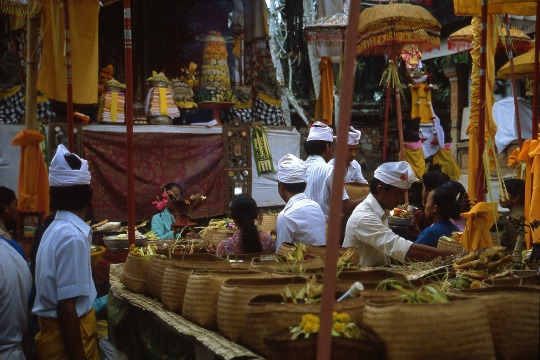 |
CULTURES IN CONTEXT Bali: Ancient and Modern 8. Religious Beliefs and Temples : 088-103 |

088. Living as many of us do in societies overwhelmed by scientific and economic values, it is hard to imagine a world in which spiritual concerns, in one way or another, dominate everyday life: but this is true in Bali. Here both social and economic affairs are guided and controlled by religious beliefs. |
089. Long ago the Balinese were animists … that is, people who worship nature. They gathered at sacred places to celebrate the blessings of the sun and other natural phenomena. They prayed to gods whom, they assumed, must surely live high up among the clouds: and they built shrines like this in fields and forests. |
090. Two thousand years ago a mixture of Hindu and Buddhists beliefs was imposed upon these ancient practices, but did not replace them. As a result the beliefs and customs of the Balinese today are exceedingly complex and have little in common with those of Hindus in India. They long ago rejected suttee (in which widows were burnt on their husband’s funeral pyre). Nor did they believe in either purdah, or child marriage. |
091. In theory the Balinese honour the same three Hindu gods … Shiva, Brahma and Vishnu … but their worship is interwoven with worship of the gods of nature. My friends worshipped their gods here in their own temple, where from an early age the children were taught to be devout in their prayers. |
092. However the people of Bali also believe in many lesser beings … including the spirits of mountains and seas, sun and moon, wind and water, trees and crops, fertility and sickness (and many other spirits) together with their own ancestors. Note the shrine in the bottom right-hand corner of the picture. |
093. The greatest of these spirits live on Mount Agung, simply because it is the highest mountain in Bali: and the island's most important temple is located there … in spite of volcanic eruptions. For the people of Bali this mountain has always been the centre of the universe; and, since it reaches to the heavens, it provides a way for their gods, and the spirits of their ancestors, to come down to earth from time to time. |
![]()
TEMPLES
![]()
094. In India you see statues of gods everywhere; but not in Bali. Here people honour the spiritual essence of each god, not his or her physical form. So, instead of carving images to represent their gods, they provide shelters (shrines) in every temple where these spirits can rest, when visiting the earth. |
095. There are actually more temples in Bali than there are homes … since every family has its own shrine, and every village has at least two or three temples for the community’s use. There are shrines like this in fields to save the crops … |
096. And shrines at crossroads and intersections to protect passers-by. Visitors to Bali meet with shrines and temples everywhere ... thousands of them. |
097. To enter a temple you pass through two gates (shown Frame 94). There are steps, as you'd expect, to shut out the evil spirits that stay close to the ground and a wall inside to block out those that travel only in straight lines. Both gates are placed on the side nearest the sea, so you always enter temples looking towards the mountains. |
098. Inside the front gate there will be an open courtyard used for dancing (which invariably has a religious basis), for cockfights, for communal gatherings, and for the preparation of offerings to the gods and food for worshippers. |
099. Beyond the second gate is a sacred inner courtyard with shrines dedicated to Hindu deities and individual spirits. There are two rows of shrines usually: but the most important ones are always on the side closest to the mountains. |
100. Many of the thrones provided for individual gods have thatched roofs … a series of them in major temples, though always an odd number. |
101. Three roofs indicate a shrine dedicated to the goddess of the rice fields. Seven are provided for Brahma, nine for Vishnu and eleven for Shiva. |
102. In addition to these individual shrines there will be a large pavilion offering a communal resting place for the spirits of all gods. Offerings of food will be left there to meet the needs of spirits during their stay. |
103. Visitors from the "developed world" sometimes write off Balinese beliefs as "superstition": but if the purpose of religion is to help people live in harmony … with one another and with their environment … it certainly works in Bali, and works well. Christian missionaries were sent here long ago but were unable to make any converts. |
![]()
Text, photos and recordings
by John Tyman
Intended for Educational Use
Only.
Contact Dr. John Tyman at johntyman2@gmail.com
for information regarding public
or commercial use.
![]()
www.hillmanweb.com
Photo processing, Web page layout,
formatting and hosting by
William
Hillman ~ Brandon, Manitoba ~ Canada